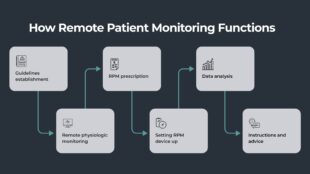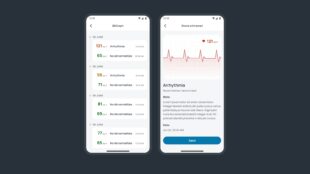Healthcare is undergoing a profound transformation. Remote Patient Monitoring (RPM) is a data-driven technology that is not just about improving patient outcomes; it’s about operational efficiency and financial sustainability. In 2024, harnessing the power of RPM is no longer a futuristic aspiration but an imperative for healthcare providers seeking to thrive in a rapidly evolving ecosystem.
This comprehensive guide provides the foundational score – a roadmap to navigate the opportunities and challenges of RPM implementation, maximizing its transformative potential for your business.
RPM transcends the limitations of traditional healthcare models, delivering a harmonious blend of benefits for both patients and providers:

- Enhanced Patient Care: Continuous data streams empower proactive interventions, optimize treatment plans, minimize complications, and improve overall well-being. Imagine fewer readmissions, better chronic disease management, and heightened patient satisfaction, all resonating with the melody of personalized care.
- Streamlined Operations: RPM reduces unnecessary in-person visits, freeing up valuable resources for complex cases. Patients become active participants in their treatment, leading to increased medication adherence and improved outcomes. Think optimized workflows, reduced administrative burdens, and a more cost-effective care delivery model.
- Data-Driven Decisions: The wealth of real-time data generated by RPM unlocks a new level of insights, informing strategic resource allocation, personalized treatment plans, and even future healthcare innovations. This analytical symphony empowers data-driven decision-making, optimizing every note of your performance.
- Financial Harmony: Early detection and prevention of health issues translate into significant cost reductions. Think minimized hospital stays, reduced medication errors, and lower administrative expenses. RPM harmonizes financial sustainability with enhanced patient care, composing a healthier bottom line for your business.
Benefits of Remote Patient Monitoring Implementation
RPM isn’t just about monitoring vital signs from afar. It’s a symphony of interconnected advantages that benefits both patients and providers:
- Enhanced Patient Care: Continuous data streams allow for proactive interventions, preventing complications and improving overall well-being. Imagine fewer hospital readmissions, better chronic disease management, and personalized care tailored to individual needs.
- Streamlined Operations: RPM reduces unnecessary clinic visits, freeing up resources for complex cases.
- Cost Savings: Early detection of health issues translates to significant cost reductions. Think minimized hospital stays, reduced medication errors, and lower administrative burdens.
- Data-Driven Decisions: RPM provides a wealth of real-time data, enabling data-driven decision-making for optimized treatment plans, resource allocation, and even future healthcare innovations.
- Improved Patient Engagement: By involving patients in their own care journey, RPM fosters trust and collaboration.
Trends and Technologies Shaping RPM
The RPM landscape is constantly evolving, with exciting trends emerging:
- AI and Machine Learning: These technologies are transforming data analysis, providing actionable insights for personalized care, and even predicting potential health risks before they occur.
- IoT Integration: Smart devices are seamlessly integrating with RPM systems, enabling continuous monitoring of vital signs, medication adherence, and even environmental factors impacting health.
- Telehealth Expansion: Remote patient monitoring software is paving the way for broader telehealth adoption, making healthcare accessible even in remote areas and reducing geographical barriers.
Implementing RPM for Optimal Results
While RPM’s potential is undeniable, successful implementation requires careful orchestration:
- Define Your Goals: Identify your specific needs and challenges, whether it’s improving chronic disease management, reducing readmissions, or enhancing patient engagement.
- Choose the Right Instruments: Select an RPM system that aligns with your budget, technology infrastructure, and specific needs. Consider factors like data security, user-friendliness, and integration with existing systems.
- Harmonize Technology and Workflow: Ensure seamless integration of RPM into your existing operations. Train staff on new technologies and processes, and create clear communication channels for data interpretation and action.
- Data Integrity: Leverage data analytics to extract actionable insights from the wealth of information generated by RPM. Invest in skilled data analysts and the right tools to transform raw data into meaningful decisions.
- Embrace Collaboration: Partner with technology providers, healthcare institutions, and patient advocacy groups to share best practices, address challenges, and maximize the impact of RPM.

Conclusion
By understanding its potential, navigating its implementation, and embracing a collaborative approach, you can leverage RPM to compose a symphony of enhanced patient care, streamlined operations, and tangible ROI. The future of healthcare is not just about listening to heartbeats, it’s about orchestrating a data-driven harmony for a healthier, more profitable tomorrow.
Remote Patient Monitoring takes center stage, wielding data as its baton. This technology conductor promises a symphony of enhanced care: fewer readmissions, minimized errors, empowered chronic disease management, and cost savings beyond imagination. But, like any masterpiece, execution requires meticulous attention. Compose your goals, choose your instruments wisely, and rehearse data analysis and workflows.
Collaborate with diverse players to amplify the impact. Embracing RPM is not just implementing a technology; it’s conducting the healthcare harmony of the future, one data-driven note at a time. Join the performance and listen to the resounding applause of enhanced care, empowered patients, and a healthier tomorrow.

